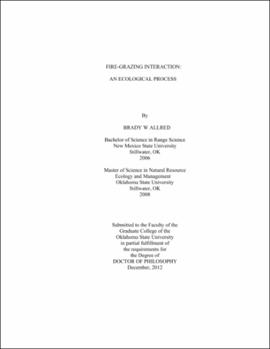| dc.contributor.advisor | Fuhlendorf, Samuel | |
| dc.contributor.author | Allred, Brady W. | |
| dc.date.accessioned | 2013-11-26T08:26:08Z | |
| dc.date.available | 2013-11-26T08:26:08Z | |
| dc.date.issued | 2012-12 | |
| dc.identifier.uri | https://hdl.handle.net/11244/6841 | |
| dc.description.abstract | The ecological interactions between fire and grazing are widespread throughout fire-prone ecosystems. It is an ecological process that drives ecosystem structure and function, influencing broad, landscape level events to fine, localized processes. The fire-grazing interaction occurs when spatially distinct fires are present across a landscape and move through time, forcing grazing animals to choose among burned and unburned areas. The mechanisms of this interaction occur at multiple levels. At broad, landscape level scales, animals are attracted to and focus their grazing on recently burned areas. This attraction decreases as the amount of time since fire progresses. For bison (Bison bison) and cattle (Bos taurus) in tallgrass prairie of North America, the influence of time since fire supersedes most landscape features (e.g., distance to water, topography, etc.), indicative of the overall strength of the fire-grazing interaction. | |
| dc.description.abstract | Mechanisms of the fire-grazing interaction are also present at finer, patch level scales. Forage quality and quantity differences between burned areas are responsible for preferential grazing of burned areas. Forage quality is inversely related to time since fire, so that recently burned areas are greatest in quality, while areas with greater time since fire are significantly lower. The opposite relationship is present with forage quantity, with burned areas having small amounts of quantity compared to areas with greater time since fire. Tradeoffs between forage quality and quantity emerge and influence the attraction of grazing animals to burned areas. | |
| dc.description.abstract | The light environment at finer, plot level scales is also determined by the amount of time since fire within the fire-grazing interaction. The preferential grazing of recently burned areas maintain high light environments throughout the growing season. These areas differ from that of fire alone, where light limitations quickly return after fire. The high light environment allows for increased photosynthetic rate of dominant prairie plants, but at the expense of low leaf area through continual preferential grazing by animals. As a result, total carbon gain by plants is reduced compared to areas with greater time since fire. These results feedback and affect forage quality and quantity. | |
| dc.format | application/pdf | |
| dc.language | en_US | |
| dc.rights | Copyright is held by the author who has granted the Oklahoma State University Library the non-exclusive right to share this material in its institutional repository. Contact Digital Library Services at lib-dls@okstate.edu or 405-744-9161 for the permission policy on the use, reproduction or distribution of this material. | |
| dc.title | Fire-grazing interaction: An ecological process | |
| dc.contributor.committeeMember | Engle, David | |
| dc.contributor.committeeMember | Elmore, R. Dwayne | |
| dc.contributor.committeeMember | Joern, Anthony | |
| osu.filename | Allred_okstate_0664D_12413.pdf | |
| osu.accesstype | Open Access | |
| dc.type.genre | Dissertation | |
| dc.type.material | Text | |
| thesis.degree.discipline | Natural Resource Ecology and Management | |
| thesis.degree.grantor | Oklahoma State University | |
